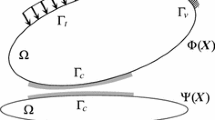Abstract
Dual analysis, requiring a pair of compatible and equilibrated solutions, has been well used for strict error estimation of many problems, including contact problems. Compatible solution is easily obtained by conventional displacement-based finite element method (FEM), while getting the equilibrated solution is not straightforward. To this end, an equilibrium finite element method (EFEM) is developed in this paper for equilibrated solution of contact problems. In doing so, there are two key steps. The first is the establishment of complementary energy principle for contact problems, along with inequality pressure constraint on contact force. In the second step, a traction-based equilibrium element is developed to construct the discrete equilibrated stress field, with which the complementary energy formulation turns into a quadratic programming problem. How to get strict bounds for the discretization error in compatible or equilibrated solution by dual analysis is also addressed. Numerical examples are finally conducted to see the performance and the availability to strict error estimation of the proposed EFEM.


















Similar content being viewed by others
References
Wriggers P, Laursen TA (2006) Computational contact mechanics, vol 2. Springer, Berlin
Debongnie J-F, Zhong H, Beckers P (1995) Dual analysis with general boundary conditions. Comput Methods Appl Mech Eng 122(1–2):183–192
Coorevits P, Hild P, Pelle J-P (2000) A posteriori error estimation for unilateral contact with matching and non-matching meshes. Computer Methods in Applied Mechanics and Engineering 186(1):65–83 https://www.sciencedirect.com/science/article/pii/S004578259900105X
Wang L, Zhong H (2017) Upper and lower bounds on quantities of interest for contact problems. Comput Methods Appl Mech Eng 317:817–835
Carstensen C, Scherf O, Wriggers P (1999) Adaptive finite elements for elastic bodies in contact. SIAM J Sci Comput 20(5):1605–1626. https://doi.org/10.1137/S1064827595295350
Ladeveze P, Leguillon D (1983) Error estimate procedure in the finite element method and applications. SIAM J Numer Anal 20(3):485–509
Ladevèze P, Pelle J-P (2005) Mastering calculations in linear and nonlinear mechanics, vol 171. Springer, Berlin
Wang L, Zhong H (2015) A unified approach to strict upper and lower bounds of quantities in linear elasticity based on constitutive relation error estimation. Comput Methods Appl Mech Eng 286:332–353
de Almeida JM, Pereira OA (2006) Upper bounds of the error in local quantities using equilibrated and compatible finite element solutions for linear elastic problems. Computer Methods in Applied Mechanics and Engineering 195(4):279–296 adaptive Modeling and Simulation. https://www.sciencedirect.com/science/article/pii/S0045782505000873
Chamoin L, Ladevèze P (2008) A non-intrusive method for the calculation of strict and efficient bounds of calculated outputs of interest in linear viscoelasticity problems. Computer Methods in Applied Mechanics and Engineering 197(9):994–1014 https://www.sciencedirect.com/science/article/pii/S004578250700401X
Fraeijs de Veubeke B, Sander G, Beckers P (1972) Dual analysis by finite elements: linear and non linear applications. Tech. rep, Air Force Flight Dynamics Laboratory
Robinson J (1985) The mode-amplitude technique and hierarchical stress elements-a simplified and natural approach. Int J Numer Meth Eng 21(3):487–507
de Almeida JM, Maunder EA (2017) Equilibrium finite element formulations. Chichester, UK
Maunder E, de Almeida JM, Ramsay A (1996) A general formulation of equilibrium macro-elements with control of spurious kinematic modes: the exorcism of an old curse. Int J Numer Meth Eng 39(18):3175–3194
Pereira OA (2008) Hybrid equilibrium hexahedral elements and super-elements. Commun Numer Methods Eng 24(2):157–165
Maunder EAW, Moitiniho de Almeida J (1997) Hybrid-equilibrium elements with control of spurious kinematic modes. Comput Assist Mech Eng Sci 4:587–606
Maunder E, Moitinho de Almeida J (2005) A triangular hybrid equilibrium plate element of general degree. Int J Numer Meth Eng 63(3):315–350
Parrinello F (2021) Hybrid equilibrium element with interelement interface for the analysis of delamination and crack propagation problems. Int J Numer Meth Eng 122(1):190–218
Parrinello F, Borino G (2021) Hybrid equilibrium element with high-order stress fields for accurate elastic dynamic analysis. Int J Numer Meth Eng 122(21):6308–6340
Parrinello F (2013) Restraining approach for the spurious kinematic modes in hybrid equilibrium element. Comput Mech 52(4):885–901
Moitinho de Almeida J, Maunder E (2013) A general degree hybrid equilibrium finite element for kirchhoff plates. Int J Numer Meth Eng 94(4):331–354
Maunder E, Izzuddin B (2013) A hybrid equilibrium element for folded plate and shell structures. Int J Numer Meth Eng 95(6):451–477
Maunder E, Moitinho de Almeida J, Almeida Pereira O (2016) The stability of stars of simplicial hybrid equilibrium finite elements for solid mechanics. Int J Numer Meth Eng 107(8):633–668
Wang L, Zhong H (2014) A traction-based equilibrium finite element free from spurious kinematic modes for linear elasticity problems. Int J Numer Meth Eng 99(10):763–788
Wang L, Zhong H (2015) Stable linear traction-based equilibrium elements for elastostatics: Direct access to linear statically admissible stresses and quadratic kinematically admissible displacements for dual analysis. Int J Numer Meth Eng 101(12):887-932
Kuss F, Lebon F (2009) Stress based finite element methods for solving contact problems: comparisons between various solution methods. Adv Eng Softw 40:697–706
Boyd S, Vandenberghe L (2004) Convex optimization. Cambridge University Press, Cambridge
Johnson C, Mercier B (1978) Some equilibrium finite element methods for two-dimensional elasticity problems. Numer Math 30:103–116
Acknowledgements
This work is supported by the National Key Research and Development Program of China (No. 2020YFC2201101), the National Natural Science Foundation of China (No. 11702336), and the Natural Science Foundation of Guangdong Province (No. 2018B030311001).
Author information
Authors and Affiliations
Corresponding author
Ethics declarations
Conflict of interest
The authors declare that they have no conflict of interest.
Additional information
Publisher's Note
Springer Nature remains neutral with regard to jurisdictional claims in published maps and institutional affiliations.
Rights and permissions
Springer Nature or its licensor holds exclusive rights to this article under a publishing agreement with the author(s) or other rightsholder(s); author self-archiving of the accepted manuscript version of this article is solely governed by the terms of such publishing agreement and applicable law.
About this article
Cite this article
Zheng, Q., Liu, J. & Wang, L. An equilibrium finite element method for contact problem with application to strict error estimation. Comput Mech 71, 55–70 (2023). https://doi.org/10.1007/s00466-022-02213-7
Received:
Accepted:
Published:
Issue Date:
DOI: https://doi.org/10.1007/s00466-022-02213-7




